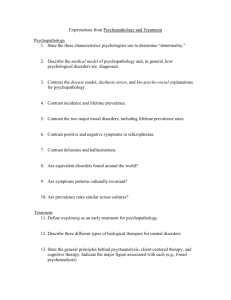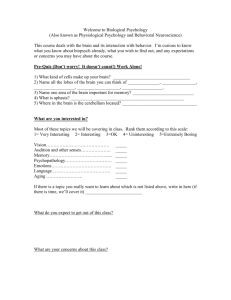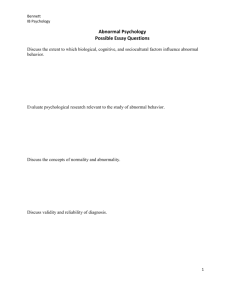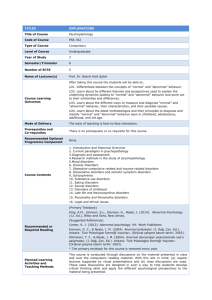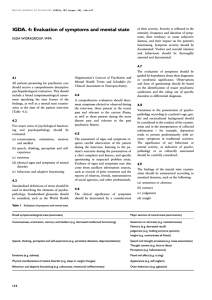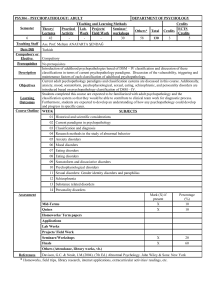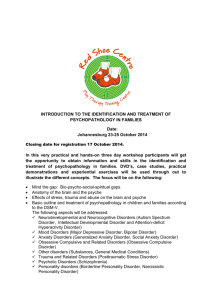PSYCHOPATHOLOGY - Covenant University
advertisement
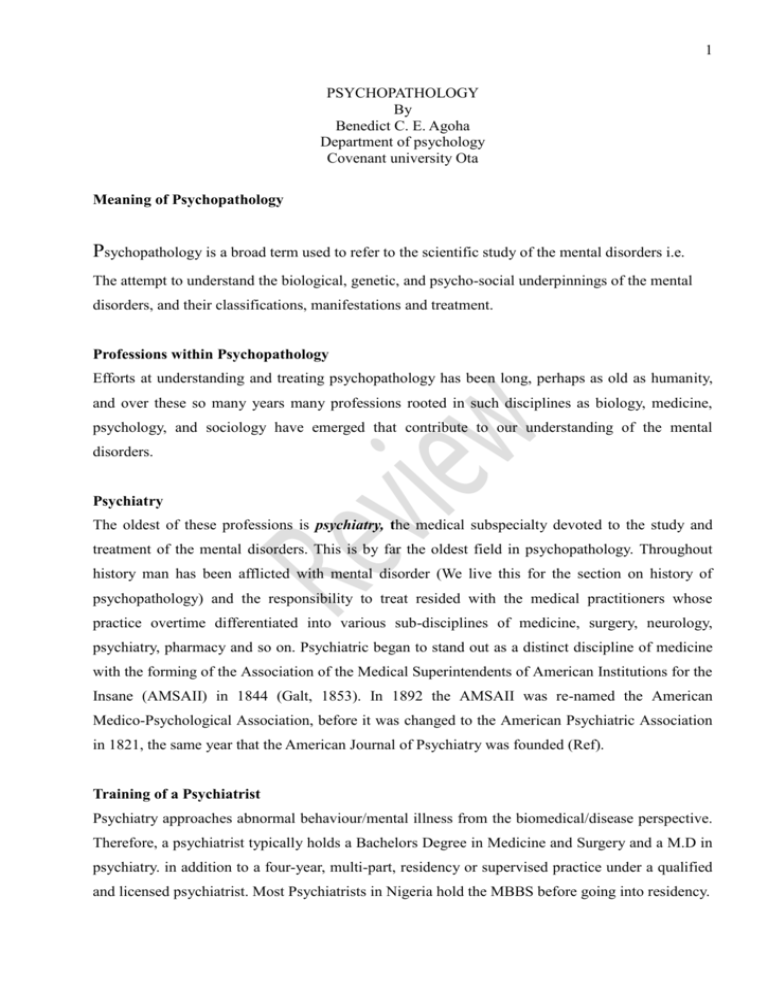
1 PSYCHOPATHOLOGY By Benedict C. E. Agoha Department of psychology Covenant university Ota Meaning of Psychopathology Psychopathology is a broad term used to refer to the scientific study of the mental disorders i.e. The attempt to understand the biological, genetic, and psycho-social underpinnings of the mental disorders, and their classifications, manifestations and treatment. Professions within Psychopathology Efforts at understanding and treating psychopathology has been long, perhaps as old as humanity, and over these so many years many professions rooted in such disciplines as biology, medicine, psychology, and sociology have emerged that contribute to our understanding of the mental disorders. Psychiatry The oldest of these professions is psychiatry, the medical subspecialty devoted to the study and treatment of the mental disorders. This is by far the oldest field in psychopathology. Throughout history man has been afflicted with mental disorder (We live this for the section on history of psychopathology) and the responsibility to treat resided with the medical practitioners whose practice overtime differentiated into various sub-disciplines of medicine, surgery, neurology, psychiatry, pharmacy and so on. Psychiatric began to stand out as a distinct discipline of medicine with the forming of the Association of the Medical Superintendents of American Institutions for the Insane (AMSAII) in 1844 (Galt, 1853). In 1892 the AMSAII was re-named the American Medico-Psychological Association, before it was changed to the American Psychiatric Association in 1821, the same year that the American Journal of Psychiatry was founded (Ref). Training of a Psychiatrist Psychiatry approaches abnormal behaviour/mental illness from the biomedical/disease perspective. Therefore, a psychiatrist typically holds a Bachelors Degree in Medicine and Surgery and a M.D in psychiatry. in addition to a four-year, multi-part, residency or supervised practice under a qualified and licensed psychiatrist. Most Psychiatrists in Nigeria hold the MBBS before going into residency. 2 Clinical Psychology By the beginning of the 20th century only psychiatry and neurology were interested in psychopathology. Psychologists were merely interested in understanding the mind. Most of the assumptions were not tested. However, a major shift began to take place with the establishment of psychological laboratories across the world following the example of Wilhelm Wundt (1879). The laboratories enabled psychological principles to be tested in various fields like education and medicine. The first psychological clinic was established in 1896 by Lightner Witmer majorly for the purpose of attending to behavioural problems associated with school children. As indicated in Hugo Munsterberg book psychotherapy written in 1903, these early efforts met with very limited success. However, later successes recorded with the military during both the first and second world wars saw the emergence of clinical psychology as a front line service provider, in addition to being a mental testing profession. Training and Qualifications Essentially a Clinical Psychologist is trained in the psychosocial model and treats psychopathology using psychotherapy. The clinical Psychologist has a Bachelors degree , a Master of Science and a Ph.D. in Psychology or Psy.D or D.Clin. Psych. This sums up to about 8 to 9 years of training in addition to one or two years of internship . In Nigeria and some other countries of the world a Masters Degree holder is allowed to practice Clinical Psychology, provided the period of internship is served. Psychiatric Social Work (PSW) Psychiatric Social Work. The psychiatric social Worker holds a M.S.W in Psychiatric social work. They work from a purely social model. In mental health care the Social Worker seeks to manipulate the social milieu to get the Patient stabilised. Their services, target individuals with high needs. Psychiatric Social Workers may diagnose psychopathology and also use psychotherapy to treat their patient. There other people who play ancillary roles in the care of the mentally ill such as the Occupational therapist, Pharmacist, Radiologist etc. But they are not regarded as mental health professionals. Models of Psychopathology 3 A model is a simplified pattern used for analysing and solving problems. There are different models of abnormal behaviour within and outside of Psychology. Models of psychopathology attempt to explain the origins of psychopathology and, by extension, provide approach to treatment. Some of these are discussed in the following section. Biological/Medical model The biological model of abnormal behaviour assumes that psychopathology result from specific disease process, or biological dysfunction. And therefore, People with behavioural disorders are to be treated with specific physical means such as pharmacological intervention, electroshock or even surgery. The model is also referred to as the organic model, the traditional medical model, or the disease model (Tyrer & Steinberg, 1998). The medical model received a boost in 1913 when Treponema pallidum, syphilis bacteria that caused general paresis was isolated by Noguchi and Moore from brain tissue (Fullford, Thornton & Graham, 2006). With this demonstration of a neurological cause for a psychiatric disorder the search for causes of other psychiatric conditions received re-energising. Cerebral malaria and HIV/AIDS delirium are other examples of how disease process may manifest in psychiatric disorders. Biochemical imbalances such as hormonal fluctuations may also lead to abnormal behaviour. Some of the contributions of the biological model include the classificatory system currently rpresented in the Internatio in chapter 5 of The International Classification of Diseases—Tenth Edition (ICD-10) and the Diagnostic and Statistical Manual of Mental Disorders -5th edition (DSM-V) and the mental health law. e.g. The Nigerian lunacy act 1958. other contributions include physical treatment, scientific research methods like case-control studies and randomized control trial. Psychoanalytic Model This model is associated with Sigmund Freud (1856-1939), a Swiss neurologist. Freud undertook the challenge to finding solution to the neuroses which had no demonstrable organic basis in his day. Assumptions. The psychoanalytic model assumes that abnormal behaviour results from intrapsychic conflicts within the individual. Freud believed that all of human behaviour derived from physiological need states, drives. These states generate psychic or mental energy called libido which constantly seeks to break from the unconscious portion of the mind into consciousness. The libido seeks to be 4 satisfied instantly and always. Freud also held that the preconscious layer of the psyché, the ego provides censorship for id impulses (libido) that contradict superego (Conscious portion) content. It operates on reality principle i.e. helps direct libido in line with reality and socially accepted standards. Any unacceptable wishes, memories, or desires are driven back to the unconscious, a mechanism called repression, or modified using the ego defence mechanisms. Initially he argued that repressed memory of early sexual seduction was the main underlying cause of psychopathology (Freedheim & Weiner, 2003 Freud & Breuer, 1895). Early sexual seduction experiences that were repressed were said to re-emerge in later life to give rise to hysteric symptoms. This is known as seduction theory. This theory derived from the analysis of five case histories, including Bertha Pappenheim, popularly known as Anna O, Breuer’s Patient who suffered from multiple somatic complaints. Anna O had claimed that simply reporting her stream of thoughts made her feel better. Freud introduced the structural model to be able to revise his seduction theory. He believed that excessive repression led to a compromise between antithetical thoughts which got deflected into a neurosis. SUPEREGO Conscious Preconscious EGO (IT) Unconscious ID (IT) Figure 1: A schematisation of the topographical model of consciousness ID content is completely unconscious and operates on the pleasure principle; the Ego corresponds to the pre-conscious state and operates on reality principle. It helps the ID achieve its aims in consultation with the superego that is a representation of the social moors and taboos. Contributions of psychoanalytic model Consciousness. The work of Freud and his associates led to a new way of viewing consciousness. It demonstrated that mental life contained material acquired over years for which the individual lacked conscious awareness. These unconscious contents may intrude and influence consciousness in very practical ways and also play active role in the emergence of psychopathology. The model 5 also showed that people can voluntarily keep unwanted thoughts and ideas out of conscious awareness. So humans are not passive recipients but also active processors of information. Effects of early life experience on later adult life We learn from psychoanalysis that experience in early life may shape their behaviour and interpersonal relationships in later years. Psychotherapy, a method of treating people through talking, was a major contribution of psychoanalysis. In this way mental health practice was no longer the preserve of psychiatry and neurology as medical training was no longer necessary prerequisite to treating psychopathology. The emergence of clinical psychology owe much to this contribution of psychoanalysis. Criticism of psychoanalysis Untestable hypothesis- Many of the core assumptions underlying psychoanalysis were simply untestable. Concepts like the id, ego and superego could neither be observed nor tested. A second issue pertained to overemphasis on sex. Classical psychoanalysis placed too much emphasis on sex. For instance even sucking behaviour of infants was explained in erotic terms. Economic Wastefulness. Once in therapy a person was expected to continue in it for so many years. In fact, it was believed that analysis can never be completed. So the Patient had to return for analysis periodically. Another the availability of Alternative Explanations. The phenomena that Freud described can be described in different ways. For instance Dollard and Miller (1959) recast the whole of psychoanalysis in behaviouristic mould. Also many of his associates, even in his life time proffered alternative explanations. Examples include Fred Adler, Carl G Jung, Karen Horney, and Erik Erikson. Moreover, more efficacious and less time consuming versions of psychoanalytic/dynamic resemble approaches derived from other models. For example, Supportive-expressive Dynamic psychotherapy bears very close semblance to Cognitive-Behavioural therapy (CBT). Cognitive-Behavioural Model. This model is a blend of cognitive and behavioural theories. In recent times the distinction between behavioural model and cognitive models has narrowed so much that experts now prefer to capture both of them with the term cognitive-behavioural. 6 Assumptions All behaviours, normal or abnormal are learned through the same processes of classical and operant conditioning; abnormal behaviour is considered to be a set of habits that can be changed through unlearning the undesirable behaviour and replacing them with new sets of behaviour. In classical cognitive theory (Beck, Lazarus) psychopathology result from the set of faulty thinking patterns and beliefs a person has about the events that happen to them and the world around them. Achievement Development of fast and specific techniques Therapeutic approaches that are based on Cognitive-behavioural model provide specific and flexible means of treating disorders. A CBT package can be easily modified to suit any specific conditions. Besides prescriptions for home practice could be made in the same way that drugs could be prescribed to be taken for specific ailments and at specific times. This reduces the burden on both client and therapist, as well as shorten the duration of treatment. Evidence-Based Practice The effectiveness of CBT has been proved in controlled trial experiments. Sometimes its effectiveness has been equal or superior to medication. It also holds some promise for the treatment of complex disorders like schizophrenia. Family Systems Model Assumptions This model assumes that patterns of interaction, shared cognitive styles, within the family and in the wider social context of the Client. Family system approaches may be grouped focus one of three areas of concern (Carr, 2001): (1) problem-maintaining behaviour patterns (2) problematic and constraining belief systems (3) Historical, contextual and constitutional predisposing factors. Adherents to the first school of thought emphasise the role of patterns of interaction among family members in maintaining abnormal behaviour. They therefore aim at disrupting these patterns of interaction. The second group target the central belief system of the family that gives rise to repetitive patterns which maintain abnormal behaviour; and the third group. The therapeutic effort for this group of practitioners is directed towards the modification of the pathogenic belief system; 7 and finally, the third group highlight those historical, contextual and constitutional factors which predispose family members to adopt particular problem-causing belief systems. The practices employed by adherents to this school address those historical, contextual and constitutional factors (Carr, 2001, p193). Typically a wide network of family relatives is made to partake in the therapy sessions. Achievements. Firstly, System theory highlight the role of social milieu in the aetiology and treatment of abnormal behaviour. Secondly, it is cost effective in terms of time given that many people may be treated at the same time and in the same venue. Another high point of this approach is its proven effectiveness; it has been shown to be effective for a wide variety of problems in Adults and children. Systems theory can offer an integrative framework for comprehending not just the role of social factors but also those of biological and intra-psychic factors in the understanding and treatment of psychological difficulties. And it is suited for complex cases involving family members. A Case. Mrs Akpan is a 38 year old mother of mother of 4 children aged between 7 and 2 the last of which was born with a developmental disorder that left her grossly retarded. She presented with verbal and physical aggression, paranoia, second person auditory, and visual hallucinations. In addition to her role as wife and mother she also worked as a Matron in a busy ICU ward for children. Although she responded to treatment she did not recover from her negative symptoms that included anhedonia. When her husband was invited to a family therapy session the faulty communication between the couple and their wider family context was brought to the fore. And therapy effort targeted on these. An appreciable improvement was noticed within 3 weeks. (Author’s file). Limitations The limitations of the systems approach includes the danger of losing sight of the individual, and the tendency to overlook the contributions of organic factors to a particular condition of an individual. Classifying Psychopathology Modern classification in science can be traced to the efforts of the botanist, Caroleus Linnaeus and the influence of Darwinism. There was also the desire of psychiatry to follow the age-long medical tradition of classifying diseases. However, the entire history of classification reach far beyond modern times, perhaps to the earliest anthropological era. The ancient biblical writer noted that: 8 ‘...And out of the ground Yahweh God formed every beast of the field and every bird of the sky, and he brought each to the man to see what he would call it. And whatever the man called that living creature was its name’ (Gen.2:19). We are as humans faced with a plethora of phenomena which require that we name and remember them. We are thus compelled by the limited capacity of our cognitive apparatus to organise information about the world around us by reducing them into distinct categories. This allows adequate processing. We speak for instance of tall/short, white/black, high/low, men/women etc. In prehistoric times persons with psychological problems were classified is demonised. All cases were said to be caused by demons. But Plato in the 4th century BC distinguished between natural madness and divine madness. His contemporary, Hippocrates, subsequently classified madness into five distinct groups, hysteria, epilepsy, acute mental disturbance with and without fever, and chronic mental disturbance. He attributed all of his forms of madness to biological causes and prescribed physical treatments. This was extended to include psychological causes by the Greek physician and philosopher, Galen (c.200 A.D). There were various other efforts to classify psychopathology before the modern systems that now are available to us. Benefits of Classification Before now professionals in the field had difficulty communicating with one another concerning disorders. For instance, a clinician referring a client with borderline personality disorder may call it madness without fever or such a thing. This vagueness in describing the phenomenon of abnormal behaviour impeded research, diagnosis, and treatment. Therefore, classification became necessary to improve inter-professional communication, diagnosis, treatment as well as research. The Multiaxial system Earlier attempts at classification tended to the favour the single category approach where a single diagnosis is given. Presently each presenting case receives more than one diagnosis. Two major systems of multiaxial classification are available today. These are the International Classification of Diseases-10th Edition (or ICD-10) chapter 21, developed by the world health organisation and the Diagnostic and Statistical Manual for the Mental Disorders, fifth edition (DSM-V) published in March 2013. DSM-V AND ICD-10. 9 The first DSM was published in 1952. This version included vague diagnostic terms as anxiety neurosis and was heavily influenced by psychoanalytic concept of unconscious conflict. This led to its revision in 1968 with the publication of DSM -2. It reliability was also remarkably poor. Beck et al (1962) found only 54% agreement between among diagnosis made by Clinicians. In 1980 DSM-3, revised in 1987 and called the DSM 3R, another version was produced in 1994, and version 5 appeared in March 2013. Using the DSM-5, five distinct diagnoses may be made on a particular case. Theses are coded as axes 1-5: Behavioural or clinical disorders, Personality disorders and Mental retardation, Physical Condition, Psychosocial Stressors, and Global Assessment of function (GAF). The GAF is a numeric scale 1-100 used to subjectively assess psychological, occupational, and social functioning of an individual. The GAF rating scale is as presented below; 91- 100 Superior Functioning 81 - 90 Absent or Minimal Symptoms 71 - 80 Transient Symptoms 61 - 70 Some Mild Symptoms 51 - 60 Moderate Symptoms (flat affect...panic attacks...few friends, conflicts with peers ) 41 - 50 Serious Symptoms (suicidal ideation...no friends, unable to keep a job) 31 - 40 Some Impairment in Reality Testing (speech is illogical...major impairments in several areas... depressed man avoids friends...unable to work) 21 - 30 Behaviour is Influenced by Delusions or Hallucinations OR Inability to Function in Most Areas 11 - 20 Some Danger of Hurting Self or Others OR Occasionally Fails to Maintain Minimal Personal Hygiene OR Gross Impairment in Communication 1 - 10 Persistent Danger of Hurting Self or Others OR Persistent Inability to Maintain Minimal Personal Hygiene OR Serious Suicidal Act with Expectation of Death There are over 900 distinct diagnoses that could be made using the DSM-V. The ICD-10 has similar disorders but grouped under relatively fewer headings. Most clinicians in the UK use the ICD-10, while those in the U.S. prefer the DSM. All of these are compressed into broad categories like anxiety disorders, Mood and affective disorders, schizophrenia spectrum disorders, cognitive disorders, stress-related disorders, childhood disorders, personality disorders, substance use disorders, sex disorders and paraphilia. 10 The anxiety disorders have fear, worry, and apprehension is their core feature. For example a person suffering from agoraphobia may entertain irrational fear of open places like banks, markets, large religious or political gatherings etc. Examples range from simple phobias like stage fright to more complex ones like complex social phobia, and post traumatic stress disorder. Mood disorders are characterised by abnormal or subnormal variations in feeling states. Typical disorders in this nosoology include depression, bipolar affective disorder (BAD), pre-menstrual dysphoric syndrome. Stress-related disorders manifest as consequence of inappropriate response to chronic stress. They could be psychological or physical in nature, or may aggravate underlying disease conditions. Substance use disorders are due to abuse of psychoactive substances. Substance abuse is use of psychoactive substance in a manner not consistent with medical prescription or one’s culture and religion. This could lead to intoxication, dependence, withdrawal states, or induce underlying psychosis. All of these disorders my be generally referred to as adulthood psychopathology in contrast to childhood disorders like autism spectrum disorder, separation anxiety, conduct disorder, hyperactivity disorder etc which are peculiar to children. Personality disorders are not considered as clinical disorders like the ones we have discussed previously. Personality Disorders are characterized by an enduring pattern of thinking, feeling, and behaving which deviates markedly from a person's culture, and results in negative consequences. they are rigidly pervasive, have an onset in adolescence or early adulthood, are stable through time, and lead to unhappiness and impairment. There are ten types of personality disorders, all of which result in significant distress and/or negative consequences within the individual, and these have been grouped in three clusters. Cluster A: characterized by odd and/or eccentric behaviour include Paranoid personality disorder ( a pattern of distrust and suspiciousness), Schizoid (pattern of detachment from social norms and a restriction of emotions: inability to desire or form social relationships), and Schizotypal personality disorder (pattern of discomfort in close relationships and eccentric thoughts and behaviours). Cluster B: Dramatic, Emotional, and Unstable Antisocial: rule-violation with little remorse or desire to change (pattern of disregard for the rights of others, including violation of these rights and the failure to feel empathy).Antisocial personality runs an unremitting course, with the height of antisocial behavior usually occurring in late adolescence. Borderline personality disorder 11 The term ‘borderline’ was first used by Stern (1938) to describe his Patients with ‘borderline group of neuroses’ (Pollack, Otto, & Rosenbaum, 1996). The current use of the term has been streamlined to include people with unstable affect, sense of self and interpersonal relationships; chronic loneliness and emptiness (pattern of instability in personal relationships, including frequent bouts of clinginess and affection, anger and resentment, often cycling between these two extremes rapidly. These Patients may be thought to stand in the border between neurosis and psychosis. Narcissistic personality disorder: grandiose sense of self importance (pattern of grandiosity, exaggerated self-worth, and need for admiration), Histrionic: excessive emotionality and attention seeking (pattern of excessive emotional behaviour and attention Cluster C: Anxious or Fearful Obsessive-Compulsive personality disorder: persistent organization, order, and rule (pattern of obsessive cleanliness, and perfection). This is different from obsessive-compulsive disorder which is a mental disorder. Avoidant personality disorder: persistent fear and avoidance of others (pattern of feelings of social inadequacies, low self-esteem, and hypersensitivity to criticism). Dependent personality disorder: over-reliance and dependence on others for making decisions. Limitations of Classification The classification system has been criticized for various reasons. The most important of these relate to issues of validity of the nosologies. Whereas people tend to see the categories as disease entities, they do not necessarily represent an biological/or neuropsychological abnormalities, so it is difficult to say actually what they stand for. Another problem is that of overlap between categories. Symptoms are not restricted to specific categories; for example, anxiety and depression may be found in most clinical conditions as is hallucinations. This overlap makes it difficult to understand what the symptoms actually stand represent. Fourthly, the difference between normal and abnormal is only a question of degree and frequency. Most symptoms experienced in psychopathology also are part of everyday normal life. For instance, most normal people hallucinate at one time or another in their life. We are all aware of hypnagogic hallucinations, or have experienced hearing our name called when actually there is no one present. Thus, it becomes difficult to draw a line between normal and abnormal since behaviour is a continuum. There have been professionals who believe that this classification system should be discarded, Treating psychopathology 12 There various approaches to treatment of psychopathology. The treatment technique adopted by a particular clinician depends on the model s/he has adopted. People trained in the medical model employ physical techniques such as electroconvulsive therapy (ECT), pharmacology, and surgery to treat psychopathology. Generally, psychologists make use of one form of psychotherapy or the other such as behavoiur therapy, cognitive-behaviour therapy, family therapy, psychoanalytic procedures etc. to treat abnormal behaviour. Let me also mention that some clinical psychologists around the world are pushing for limited prescription right that would allow them prescribe psychotropic medicines in addition to psychotherapy. Future directions in research and practice In his introduction of his book psychotherapy (Munsterberg, 1909) Hugo Munsterberg implied that the development of scientific psychology was dependent on that of the physical sciences, especially biology; ‘...it can indeed be said that practical psychotherapy on a scientific basis can be considered almost as the ultimate point of a realistic movement; it cannot set in until psychology has reached high development, and psychology cannot set in unless biology has preceded it. There is no doubt that we are still far from this last phase of the realistic period. The practical application of scientific psychology is still a new problem.’ (P.4). He reasoned that psychology should be comparable to physics, chemistry, and biology; ‘The day of applied psychology is only dawning. The situation is indeed surprising. The last three or four decades have given to the world at last a really scientific study of psychology, a study not unworthy of being compared with that of physics or chemistry or biology.’ (p.60) True to his assertion, psychology has continued to develop alongside these disciplines. Advances in the natural sciences are indeed improving our understanding of psychopathology and psychotherapy, as well as throwing up new questions to be answered. Two examples of these relate to epigenetics and quantum physics. Epigenetics This is the term used to refer to heritable variations in cellular and physiological traits that are not due to changes in DNA sequence. Epigenetics was foreshadowed by the transformation theory of evolution enunciated by Jean-Baptiste Lamarck (1744-1829). Lamarck reasoned that traits were enhanced by frequency of use, and also reduced by disuse, and that traits modified or acquired over an 13 individual's lifetime were inheritable by the offspring. Research work like those of German Friar, Gregor Johann Mendel (20 July 1822 – 6 January 1884) on the genetics of inheritance soon discredited Lamarck. Current research is indicating that the experience of an individual may alter gene function in ways that may impair physical or mental health. For instance, fetal-infant exposure to famine in 1968-1970 Biafra has been shown to predispose to hypertension, impaired glucose tolerance and diabetes in later adult life and overweight (Hult et al., 2010). These vulnerabilities are explained by epigenetics (Ueda, 2013). Epigenetic changes have also been linked to behaviour and psychopathology (Agoha, Oguizu, and Urieto, 2010., Weaver, Cervoni, & Champgne, 2004). Research in this area is still in its infancy. With time it may become possible to diagnose abnormal behaviour from an epigenetic perspective. It might also be possible then to treat disorders with phamacological approaches that target epigenetic modifications. This is bound to redefine the field and alter the role of professions that presently deal with psychopathology. Beyond the physical:Quantum physics Rene Descartes (1596-1650) was the first person to conceive of a mind that was entirely separate from the body. introduced the concept of a separate mind and body (e.g., are separate but interact). He taught that purposeful behaviour were a product of the mind acting through the pineal gland. The principle of conservation of matter i.e. Matter can neither be created or destroyed was thought to contradict this hypothesis since creation of energy will be required for a non-material mind to influence a material mind. Thus, most neuroscientists accord to Darwin’s materialism that all phenomena, including mental phenomena and consciousness, may be explained solely in terms of the material brain activities i.e. The mind is synonymous with the brain. However, mental activities like intentionality and directedness are difficult to explain in neurobiological terms. A person may intend to alter certain aspects of physiological activity; this may be achieved by directing attention and effort through training to activity, and soon it is altered. Brain activity does not seem to be what explains intention, rather the reverse seems to be the case. It is clear today that principle of locality, that an object is only directly influenced by its immediate surroundings, has proven to be false by the study if subatomic particles. 14 Two principles of quantum physics, nonlocality and entanglement (Bell, 1964, Clauser & Freedman, 1972, Aspect, 1999) are important in this respect; entaglement is the loss of individuality by particles after interacting with each other. They begin to function like a unit and become permanently correlated with each other (Mastin, 2006). So even though they become separated by light years are still able to sense each other and respond to changes in each other’s state in instantaneous fashion in violation to the speed of light. The importance of all of this to our discuss is that man is part of the universe and connect subatomically to the rest of the universe such that we can influence one another and our surrounding by the energy we send out, and be influenced by them. This connectedness is reminiscent of Fred Adler’s community that he identified as the hallmark of mental health. Quantum physics therefore helps us understand psychopathology in very unique ways, as well as highlight the inexhaustible capability of one mind to heal itself, another mind, or the body. This is the basis of the new subfield of energy psychology. Much research is also needed in this area which like epigenomics promises to change the face of not only psychopathology but of medicine and other allied professions in the near future. Conclusion Psychopathology is the attempt to understand the origin and dynamics of such personal distress that are related to psychological dysfunction which in turn lead to impairment in the person’s observable behaviour. Psychopathological conditions are diverse, and may be experienced by all humans of all age and culture. Various approaches to treatment which derive from different notions about the cause of abnormal behaviour abound today, and advances in the natural sciences are opening up new vista of opportunity for understanding and effectively managing psychopathological conditions. References Agoha, B.C.E; Oguizu, J. O., Urieto, E.A. (2010). Gene-Environment interaction in a changing world: Implications for Clinical Psychology practice. Nigerian Journal of Clinical Psychology, 8 (1-2), 1-9. Aspect, A. (1999). Bell's inequality test: more ideal than ever. Nature, 398(6724), 189-190. Beck, A.T., Ward, C.H., Mendelson, M., Mock, J.E., & Erbaugh, J.K (1964). Reliability of psychiatric diagnosis. 2. A study of consistency of clinical judgments and ratings. Am J Psychiatry,119:351-7. Bell, J.S.(1964).On the Einstein Podolsky Rosen Paradox. Physics, 1(3f), 195—200 15 Carr, A.(2001). Abnormal Psychology, USA:Taylor & Francis Freedman , S.J., & Clauser, J. F. (1972). Experimental test of local Hidden-Variable theories. Phys. Rev. Lett., 28, 938 Freedheim, D.K., & Weiner, I.V. (2003). Handbook of Psychology (Vol.1):History of psychology. NJ:John Wiley & Sons Inc. Galt, J.M.(1853). Essays on asylums for persons of unsound mind. Richmond, Va. : Ritchies & Dunnavant. http://resource.nlm.nih.gov/101559948 Hugo, M, (1909). Psychotherapy. New York:Moffat, Yard, & Company.
